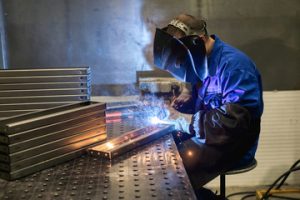Metal Fabrication Boise has long been the backbone of modern construction and manufacturing. It is the art and science of shaping raw metal into precise, functional, and durable structures. This process is fundamental to nearly every industry, from architecture to aerospace, yet its evolution continues to accelerate. As technology advances and demand diversifies, metal fabrication is entering a new era defined by innovation, efficiency, and versatility.

At its core, metal fabrication is about transformation. Sheets, rods, and alloys are cut, bent, welded, and assembled into products that power industries and support daily life. From small mechanical parts to massive structural frameworks, the scope of fabrication is vast. This diversity demands both precision and creativity, blending technical skill with engineering vision.
One of the most significant shifts in modern fabrication is the emphasis on customization. Clients now expect solutions tailored to specific applications rather than one-size-fits-all designs. This has pushed fabricators to develop flexible production processes that can accommodate unique shapes, sizes, and specifications. As a result, fabrication today is as much about problem-solving as it is about production.
The rise of automation has dramatically changed how metal fabrication operates. Machines equipped with advanced control systems now perform tasks that once required extensive manual labor. This automation not only boosts productivity but also improves accuracy and repeatability. Fabricators can achieve complex designs with minimal error, reducing waste and production costs.
Precision is the heartbeat of modern fabrication. Even the smallest deviation can compromise the integrity of a structure or component. With the help of digital modeling and computer-aided manufacturing, fabricators now work with microscopic tolerances. This precision ensures that parts fit seamlessly, function reliably, and meet stringent safety standards.
Sustainability is another driving force behind the evolution of metal fabrication. Environmental concerns have led industries to seek more efficient ways to produce and recycle metal products. Modern facilities focus on reducing material waste, optimizing energy use, and reusing scrap. These eco-conscious practices align fabrication with global sustainability goals without sacrificing quality.
Material innovation has also played a crucial role in shaping the industry’s future. Traditional metals like steel and aluminum remain dominant, but new alloys and composites are expanding possibilities. These materials offer enhanced strength, corrosion resistance, and weight reduction, unlocking new applications. As industries demand higher performance, fabricators are exploring more advanced materials to meet those challenges.
The integration of digital technologies has brought a new level of intelligence to metal fabrication. Sensors, software, and real-time monitoring allow for continuous quality control throughout production. Data analytics optimize workflows and predict maintenance needs, preventing costly downtime. This digital transformation has turned fabrication into a smart, data-driven operation.
Additive manufacturing, commonly known as metal 3D printing, is one of the most disruptive trends in the field. Instead of cutting or shaping material, it builds parts layer by layer. This approach reduces waste, shortens production times, and enables the creation of complex geometries previously impossible with traditional methods. As the technology matures, its integration into fabrication workflows is becoming more widespread.
The versatility of metal fabrication extends beyond industrial applications. Artistic and architectural projects increasingly rely on custom-fabricated metal components for their aesthetic and structural qualities. Designers collaborate with fabricators to create intricate facades, sculptures, and interior elements. This fusion of art and engineering showcases the creative potential of the craft.
Globalization has influenced the dynamics of the fabrication industry as well. As supply chains become more interconnected, fabricators must adapt to international standards and specifications. This has driven improvements in quality control, documentation, and certification processes. The result is a more robust and globally competitive industry.
Workforce development remains a critical component of successful fabrication operations. Despite increasing automation, skilled technicians and engineers are still essential. Their expertise ensures machines are used effectively and that projects meet technical requirements. Continuous training keeps the workforce aligned with evolving technologies and safety standards.
Safety is paramount in metal fabrication, where heavy machinery and high temperatures are common. Modern facilities implement rigorous safety protocols and equipment designs to protect workers. Automation has reduced exposure to hazardous tasks, further enhancing workplace safety. These improvements foster a culture where efficiency and well-being go hand in hand.
The future of metal fabrication is increasingly collaborative. Partnerships between manufacturers, designers, engineers, and clients are more integral than ever. This collaborative approach accelerates innovation and ensures projects align with both functional and aesthetic goals. By breaking down traditional silos, fabrication becomes a more dynamic and responsive industry.
As industries evolve, so too does the demand for lightweight yet strong materials. The automotive and aerospace sectors, for example, require components that improve fuel efficiency without sacrificing safety. Metal fabricators are at the forefront of developing and producing these advanced solutions. This adaptability ensures their relevance in a rapidly changing technological landscape.
Infrastructure development is another key driver of fabrication growth. As urbanization expands, the need for durable bridges, buildings, and transportation systems increases. Metal fabrication provides the structural elements that make these projects possible. Its role in shaping skylines and connecting cities underscores its importance in modern society.
Repair and maintenance services have become valuable extensions of fabrication capabilities. Instead of replacing entire systems, industries now prefer to refurbish and upgrade existing components. This approach reduces costs and environmental impact while extending the lifespan of critical infrastructure. Metal fabricators are central to this shift toward more sustainable lifecycle management.
Digital twins are emerging as a powerful tool in fabrication. These virtual replicas of physical components allow for simulations and testing before production begins. Engineers can identify potential flaws, optimize designs, and improve performance virtually. This predictive approach reduces errors, accelerates development, and enhances overall quality.
The push for faster turnaround times has also influenced fabrication practices. Just-in-time manufacturing and lean production techniques minimize delays and reduce inventory costs. These strategies improve efficiency without compromising quality. As clients demand quicker delivery, fabricators continue to refine their processes.
The economic impact of metal fabrication extends far beyond the factory floor. It supports a vast network of suppliers, contractors, and service providers. This ecosystem drives innovation, creates jobs, and fuels industrial growth. In many ways, metal fabrication is the foundation upon which modern economies are built.
Looking ahead, the convergence of technologies promises even more transformative changes. Robotics, artificial intelligence, and advanced analytics will further automate and optimize production. Human expertise will shift toward higher-level problem-solving and strategic decision-making. The result will be a more intelligent, adaptive, and resilient industry.
Sustainability will remain a central focus as environmental regulations tighten and consumer expectations evolve. Circular economy principles, where materials are continuously reused and repurposed, will become standard practice. Fabricators will play a key role in creating closed-loop systems that minimize waste and maximize resource efficiency. This evolution positions the industry as a leader in sustainable manufacturing.
The future may also see greater integration of hybrid manufacturing techniques. Combining additive and subtractive methods allows fabricators to exploit the strengths of both. This hybrid approach opens new possibilities for complex, high-performance components. It represents the next step in the evolution of fabrication capabilities.
Ultimately, the story of metal fabrication is one of constant reinvention. It has transformed from a manual craft into a sophisticated, technology-driven discipline. Its influence touches every corner of modern life, from the structures we inhabit to the machines that move us. And as innovation accelerates, its potential continues to expand.
The coming decades promise exciting opportunities for those willing to embrace change. Fabricators that invest in technology, talent, and sustainability will lead the way. Their work will shape the infrastructure, industries, and innovations of the future. In this ever-evolving landscape, metal fabrication remains a cornerstone of progress, resilience, and possibility.
From its ancient origins to its cutting-edge present, metal fabrication reflects humanity’s drive to build, improve, and innovate. It is a discipline that adapts to challenges and anticipates needs. And as it continues to evolve, it will not only shape the world we live in but also define the future we imagine. The art of shaping metal is, ultimately, the art of shaping tomorrow.




